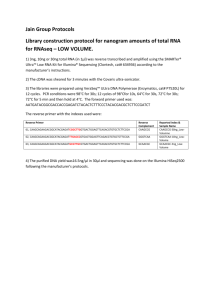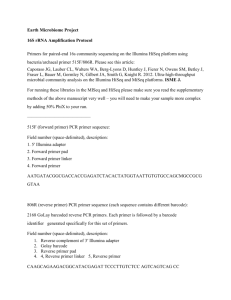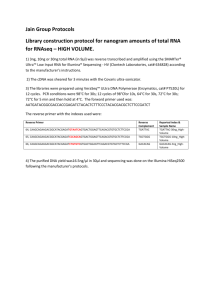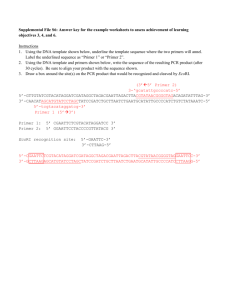Old 16S Illumina Amplification Protocol
advertisement
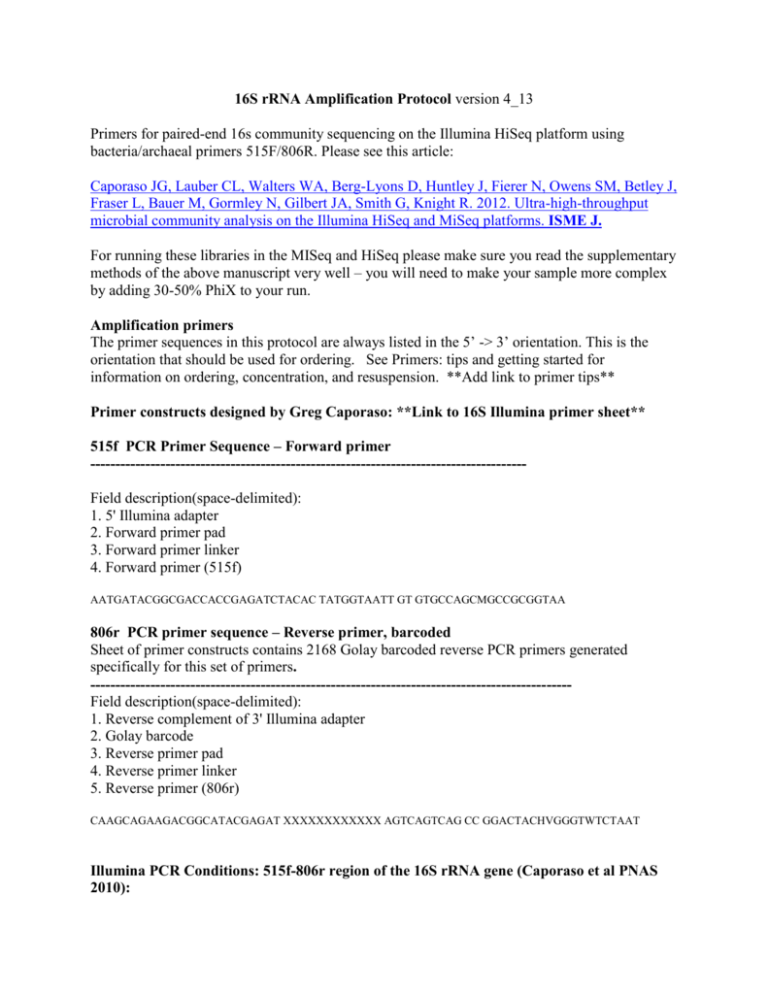
16S rRNA Amplification Protocol version 4_13 Primers for paired-end 16s community sequencing on the Illumina HiSeq platform using bacteria/archaeal primers 515F/806R. Please see this article: Caporaso JG, Lauber CL, Walters WA, Berg-Lyons D, Huntley J, Fierer N, Owens SM, Betley J, Fraser L, Bauer M, Gormley N, Gilbert JA, Smith G, Knight R. 2012. Ultra-high-throughput microbial community analysis on the Illumina HiSeq and MiSeq platforms. ISME J. For running these libraries in the MISeq and HiSeq please make sure you read the supplementary methods of the above manuscript very well – you will need to make your sample more complex by adding 30-50% PhiX to your run. Amplification primers The primer sequences in this protocol are always listed in the 5’ -> 3’ orientation. This is the orientation that should be used for ordering. See Primers: tips and getting started for information on ordering, concentration, and resuspension. **Add link to primer tips** Primer constructs designed by Greg Caporaso: **Link to 16S Illumina primer sheet** 515f PCR Primer Sequence – Forward primer --------------------------------------------------------------------------------------Field description(space-delimited): 1. 5' Illumina adapter 2. Forward primer pad 3. Forward primer linker 4. Forward primer (515f) AATGATACGGCGACCACCGAGATCTACAC TATGGTAATT GT GTGCCAGCMGCCGCGGTAA 806r PCR primer sequence – Reverse primer, barcoded Sheet of primer constructs contains 2168 Golay barcoded reverse PCR primers generated specifically for this set of primers. -----------------------------------------------------------------------------------------------Field description(space-delimited): 1. Reverse complement of 3' Illumina adapter 2. Golay barcode 3. Reverse primer pad 4. Reverse primer linker 5. Reverse primer (806r) CAAGCAGAAGACGGCATACGAGAT XXXXXXXXXXXX AGTCAGTCAG CC GGACTACHVGGGTWTCTAAT Illumina PCR Conditions: 515f-806r region of the 16S rRNA gene (Caporaso et al PNAS 2010): Complete reagent recipe (master mix) for 1X PCR reaction PCR Grade H2O (note a) 13.0 µL 5 Primer Hot MM (note b) 10.0 µL Forward primer (10µM) 0.5 µL Reverse primer (10µM) 0.5 µL Template DNA 1.0 µL Total reaction volume 25.0 µL Notes: (a) PCR grade water was purchased from MoBio Laboratories (MoBio Labs: Item#1700011) (b) Five Prime Hot Master Mix (5 prime: Item# 2200410) (c) Final primer concentration of mastermix: 0.2 µM Thermocycler Conditions for 96 well thermocyclers: 1. 2. 3. 4. 5. 6. 7. 94°C 3 minutes 94°C 45 seconds 50°C 60 seconds 72°C 90 seconds Repeat steps 2-4 35 times 72°C 10 minutes 4°C HOLD Thermocycler Conditions for 384 well thermocycler 1. 2. 3. 4. 5. 6. 7. 94°C 3 minutes 94°C 60 seconds 50°C 60 seconds 72°C 105 seconds Repeat steps 2-4 35 times 72°C 10 minutes 4°C HOLD Protocol: 1. Amplify samples in triplicate, meaning each sample will be amplified in 3 replicate 25 µL PCR reactions. 2. Combine the triplicate PCR reactions for each sample into a single volume. Combination will result in a total of 75 µL of amplicon for each sample. Do NOT combine amplicons from different samples at this point. 3. Run amplicons for each sample on an agarose gel. Expected band size for 515f/806r is roughly 300 - 350 bp. 4. Quantify amplicons with Picogreen (see manufacturers protocol; Invitrogen Item #P11496). 5. Combine an equal amount of amplicon from each sample into a single, sterile tube. Generally 240 ng of DNA per sample are pooled. However, higher amounts can be used if the final pool will be gel isolated or when working with low biomass samples. Note: When working with multiple plates of samples, it is typical to produce a single tube of amplicons for each plate of samples. 6. Clean Amplicon pool using MoBio UltraClean PCR Clean-Up Kit #12500 according to the manufacturer’s instructions. If working with more than 96 samples, the pool may need to be split evenly for cleaning and then recombined. Optional: if spurious bands were present on gel (in step 3), ½ of the final pool can be run on a gel and then gel extracted to select only the target bands. 7. Measure concentration and 260/280 of final pool that has been cleaned. For best results the 260/280 should be between 1.8-2.0. 8. Send an aliquot for sequencing along with sequencing primers listed below. IMPORTANT: Sequencing requires use of 16S and Index sequencing primers, constructs below. ------------------------Read 1 sequencing primer: ------------------------Field description(space-delimited): 1, Forward primer pad 2, Forward primer linker 3, Forward primer TATGGTAATT GT GTGCCAGCMGCCGCGGTAA ------------------------Read 2 sequencing primer: ------------------------Field description(space-delimited): 1, Reverse primer pad 2, Reverse primer linker 3, Reverse primer AGTCAGTCAG CC GGACTACHVGGGTWTCTAAT ---------------------Index sequence primer: ---------------------Field description(space-delimited): 1. Reverse complement of reverse primer 2. Reverse complement of reverse primer linker 3. Reverse complement of reverse primer pad ATTAGAWACCCBDGTAGTCC GG CTGACTGACT


